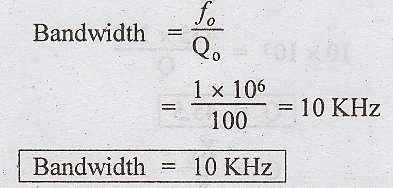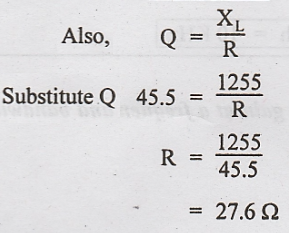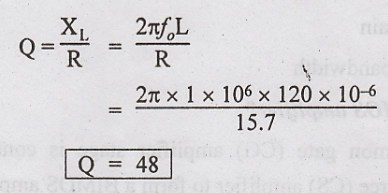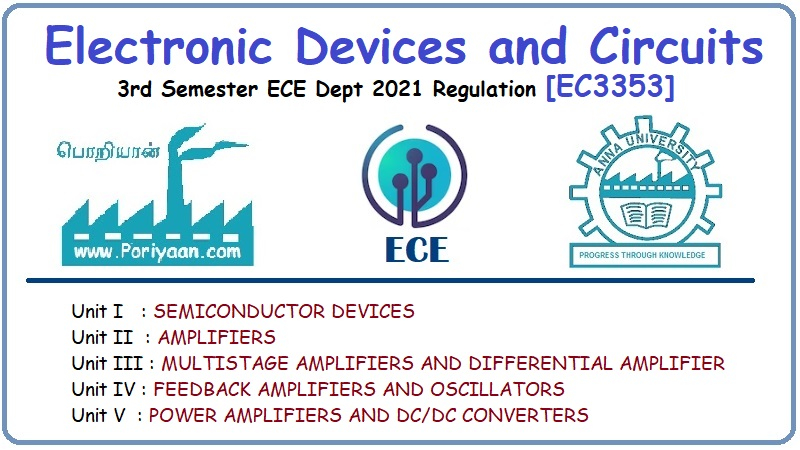Electronic Devices and Circuits: Unit III: Multistage Amplifiers and Differential Amplifier
Important Solved Problems of Multistage Amplifiers and Differential Amplifier
Anna university important solved problem of Multistage Amplifiers and Differential Amplifier
SOLVED PROBLEMS
Problem 3.4
An
amplifier has the voltage gains of AV1 = 10, AV2 = 20 and
AV3 = 40. Find the overall voltage gain.
Given:
AV1
= 10,
AV2
= 20,
AV3
= 40
To Find:
Overall
voltage gain
Solution:
Overall
voltage gain AV = AV1 . AV2 . AV3 =
10 . 20 . 40
AV = 8000
To
find voltage gain in dB = 20 log10 8000 = 78 dB
Another Method:
Voltage
gain of stage 1, GV1 = 20 log10 AV1 = 10 log10
10 = 20 dB
Voltage
gain of stage 2, GV2 = 20 log10 AV2 = 20 log10
20 = 26 dB
Voltage
gain of stage 3, GV3 = 20 log10 AV3 = 20 log10
40 = 32 dB
Total
dB voltage gain, GV = GV1 + GV2 + GV3
= 20 + 26 + 32 = 78 dB
Problem 3.5
Three
amplifier stages are connected in cascade with 0.05 V peak-to-peak input
providing 150 V peak-to peak output. If the voltage gain of the first stage is
20 and input to the third stage is 15 V peak to peak, determine
(a)
The overall voltage gain
(b)
Voltage gain of second and third stages
(c)
Input voltage of second stage
Given:
No
of stages = 3
Input
to the first stage Vin1 = 0.05 VP-P
Output
of third stage Vout3 = 150 VP-P
Voltage
gain of first stage AV1 = 20
Input
to third stage Vin3 = 15 VP-P

To find:
(a) Overall voltage gain
(b)
Voltage gain of second and third stage
(c)
Input voltage of second stage
Solution:
(a) Overall Voltage Gain

(b) Voltage gain of second and
third stage
Let
us find voltage gain of third stage

Overall
voltage gain = 3000
i.e.,
AV1 AV2 AV3 = 3000
20.
AV2. 10 = 3000
AV2
= 3000/200
AV2
= 15
(c) Input voltage of second stage
We
know that voltage gain of second stage AV2 = 15

Problem 3.6
Calculate
the bandwidth between the half-power points of circuit which resonates at 1 MHz
and has a Q of 100.
Given:
fO
= 1 MHz,
QO = 100
To Find:
Bandwidth
Solution:

Problem 3.7
A
tuned amplifier has maximum gain at a frequency of 2 MHz and bandwidth of 50
KHz. Calculate the Q-factor.
Given:
fO
= 2 MHz
BW
= 50 KHz
To Find:
Q-Factor
Solution:
We
know that

Problem 3.8
A
circuit is resonant at 455 KHz and has 10 KHz bandwidth. The inductive
reactance is 1255 Ω. What is the parallel impedance of the circuit at
resonance?
Given:
fO
= 455 KHz = 455 × 103 Hz
BW
= 10 KHz = 10 ×103 Hz
XL = 1255 Ω
To Find:
Impedance
at resonance, Z
Solution:
We
know that




Problem 3.9
A
certain power transistor meant for class A operation has zero signal power
dissipation of 20 W. If the ac output power is 5 W. Find (a) collector efficiency
(b) power rating of the transistor.
Given:
Pd.c
= 20 W
PO
= 5 W
To Find:
(a)
Collector efficiency
(b)
Power rating of transistor
Solution:
(a)
Collector Efficiency

(b)
Power rating of Transistor
Zero
signal condition implies the maximum power dissipation of the transistor.
Power rating of transistor = 20 W
Problem 3.10
An
amplifier has a collector efficiency of 50% and operates from a 24 V supply. If
the output power is 3.5 V, find the total power dissipated within the circuit.
Given:

VCC
= 24 V
PO(ac)
= 3.5 W
To Find:
Power
dissipation Pc(dc)
Solution:
We
know that
Efficiency = PO(ac)/P(dc)

Power
of 3.5 W is dissipated in the form of heat.
Problem 3.11
A
multistage amplifier has five stages each with a power gain of 30. What is the
total gain of the amplifier in dB? If negative feedback of 20 dB is applied
find the resultant gain.
Given:
Number
of stages = 5
Gain
of each stage = 30
To Find:
(i)
Total power gain
(ii)
Gain with 20 dB negative feedback
Solution:
(i)
Total Power Gain
Power
gain of one stage = 10 log 10 30
=
10 x 1.477.
=
14.77 dB
Total
power gain = No. of stages x power gain of each stage
=
5 x 14.77
Total
power gain = 73.85 dB
(ii)
Power gain with negative feedback = total power gain - feedback gain
=
73.85 - 20
Power
gain with negative feedback = 53.85 dB
Problem 3.12
An
amplifier has a voltage gain of 15 dB. If the input signal voltage is 0.8 V,
find the output voltage.
Given:
Voltage
gain = 15 dB
Input
voltage, Vin = 0.8 V
To Find:
Output
voltage, Vout
Solution:

Problem 3.13
A
tank circuit has a capacitor of 100 PF and an inductor of 100 µH. The
resistance of the inductor is 5 2. Determine (a) resonant frequency (b)
impedance at resonance (c) Q factor (d) bandwidth.
Given:
L
= 100 μH
C
= 100 PF
R
= 52 Ω
To find:
(a)
Resonant frequency
(b)
Impedance at resonance
(c)
Q-factor
(d) Bandwidth
Solution:
(a)
Resonant Frequency

(b)
Impedance at Resonance

(c)
Q-Factor

(d)
Bandwidth

Problem 3.14
A
circuit has a coil of inductance 120 μH and resistance of 15.7 Ω, which is
connected in series with a capacitor of 211 PF. determine a) resonant frequency
b) voltage drop across R, L, C c) Quality factor.
Given:
L
= 120 H
C
= 211 PF
R
= 15.72 Ω
To Find:
(a)
Resonant frequency
(b) Voltage drop across R, L, C
(c)
Quality factor
Solution:
(a)
Resonant Frequency

(b)
Voltage across R, L, C


(c)
Quality Factor

Electronic Devices and Circuits: Unit III: Multistage Amplifiers and Differential Amplifier : Tag: : - Important Solved Problems of Multistage Amplifiers and Differential Amplifier
Related Topics
Related Subjects
Electronic Devices and Circuits
EC3353 - EDC - 3rd Semester - ECE Dept - 2021 Regulation | 3rd Semester ECE Dept 2021 Regulation
